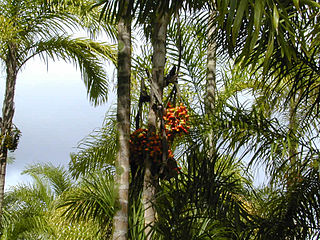
Heart of palm is a vegetable harvested from the inner core and growing bud of certain palm trees, most notably the coconut, juçara, açaí palm, palmetto, and peach palm. Harvesting of many uncultivated or wild single-stemmed palms results in palm tree death. However, other palm species are clonal or multi-stemmed plants and moderate harvesting will not kill the entire clonal palm. Heart of palm may be eaten on its own, and often it is eaten in a salad.

Bactris gasipaes is a species of palm native to the tropical forests of Central and South America. It is well spread in these regions, where it is often cultivated by smallholders in agroforestry systems or more rarely, in monoculture. Common names include peach palm in English, pijiguao or chontaduro in Spanish and pupunha in Portuguese. It is a long-lived perennial plant that is productive for 50 to 75 years on average. Its population has an important genetic diversity, leading to numerous fruits, colors, and qualities. The fruits are edible and nutritious but need to be cooked for 30 minutes to five hours. They also benefit many animals in the wild. Peach-palms are also cultivated for the heart of palm, and the trunk can make valuable timber.

Bactris is a genus of spiny palms which are native to Mexico, South and Central America and the Caribbean. Most species are small trees about 2 m tall, but some are large trees while others are shrubs with subterranean stems. They have simple or pinnately compound leaves and yellow, orange, red or purple-black fruit. The genus is most closely related to several other spiny palms—Acrocomia, Aiphanes, Astrocaryum and Desmoncus. The fruit of several species is edible, most notably B. gasipaes, while others are used medicinally or for construction.

Aiphanes is a genus of spiny palms which is native to tropical regions of South and Central America and the Caribbean. There are about 26 species in the genus, ranging in size from understorey shrubs with subterranean stems to subcanopy trees as tall as 20 metres (66 ft). Most have pinnately compound leaves ; one species has entire leaves. Stems, leaves and sometimes even the fruit are covered with spines. Plants flower repeatedly over the course of their lifespan and have separate male and female flowers, although these are borne together on the same inflorescence. Although records of pollinators are limited, most species appear to be pollinated by insects. The fruit are eaten by several birds and mammals, including at least two species of amazon parrots.
Bactris jamaicana is a spiny palm which grows in multi-stemmed clumps. It is endemic to Jamaica.
Bactris major is a small to medium-sized spiny palm which ranges from Mexico, through Central America into northern South America and Trinidad. The species is divided into three or four varieties, although the boundaries between varieties is not always clearly defined.

Bactris setulosa is a medium-sized spiny palm which is found in Colombia, Venezuela, Ecuador, Peru, Trinidad and Tobago and Suriname. It is one of the largest species of Bactris and is found at the highest elevations.
Bactris coloniata is a clustering palm with stems up to 7m tall. It is found in Colombia, Panama, and Peru. It is threatened by habitat loss.
Bactris longiseta, the huiscoyol, is a species of flowering plant in the family Arecaceae. It is found in Costa Rica and Nicaragua around Estero Real Natural Reserve. It is threatened by habitat loss.
Bactris nancibaensis is a species of flowering plant in the family Arecaceae. It is found only in French Guiana. It is threatened by habitat loss.
Bactris pickelii is a species of flowering plant in the family Arecaceae. It is found only in Brazil. It is threatened by habitat loss.
Bactris setiflora is a species of palm tree. It is endemic to Ecuador, where it is known only from Pastaza Province. It is threatened by deforestation.
The Baudó oropendola is a species of bird in the family Icteridae. It is endemic to Colombia. Its natural habitat is subtropical or tropical moist lowland forests, which are threatened by destruction. As it is only known from a small number of locations, its conservation status has been assessed as "endangered" by the IUCN.

The Panamanian spiny pocket mouse, also known as Peter's spiny pocket mouse, is a species of heteromyid rodent endemic to Panama. It is very closely related to Salvin's spiny pocket mouse, and has been placed in the same species group by some authors. It was formerly placed in the genus Liomys, which is now recognized to be paraphyletic and has been subsumed into Heteromys.

Cynolebias constanciae, also known as the pearlfish or tropical killifish, is a species of fish in the family Aplocheilidae endemic to Brazil. The name "pearlfish" comes from its long fins with elongated rays and the pearl-like markings decorating its body. It can reach sizes of up to 6 centimetres (2.4 in) TL in the wild and can live for about 2 years.
Helicia albiflora is a species of plant in the family Proteaceae. It is endemic to Papua New Guinea. It is threatened by habitat loss.
Helicia amplifolia is a species of plant in the family Proteaceae. It is endemic to Papua New Guinea. It is threatened by habitat loss.
Helicia insularis is a species of plant in the family Proteaceae. It is endemic to Papua New Guinea. It is threatened by habitat loss.
Helicia neglecta is a species of plant in the family Proteaceae. It is endemic to Papua New Guinea. It is threatened by habitat loss.







